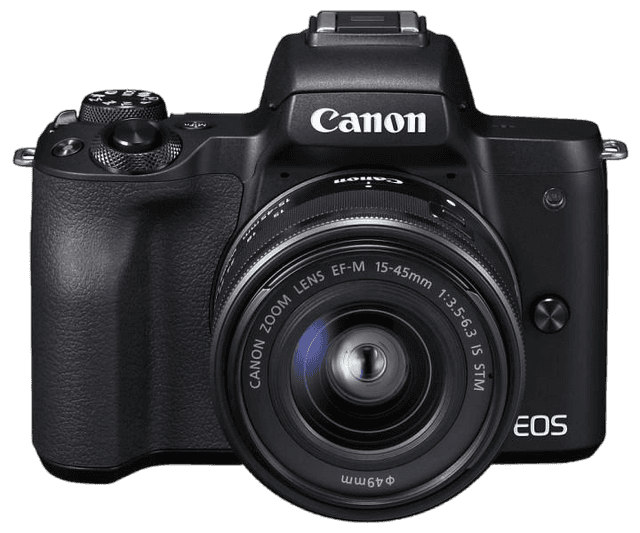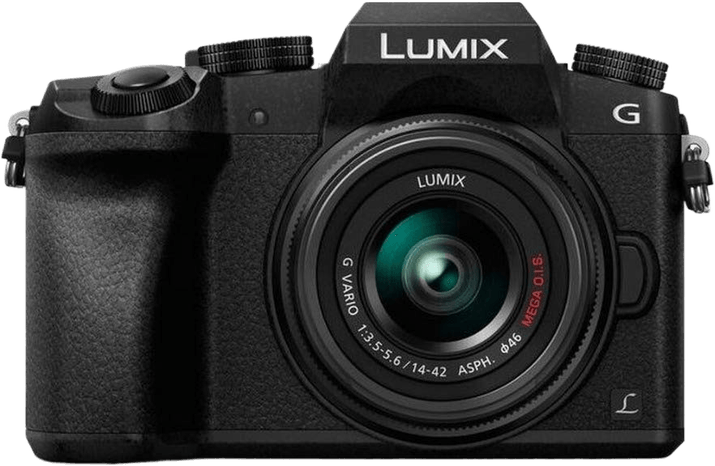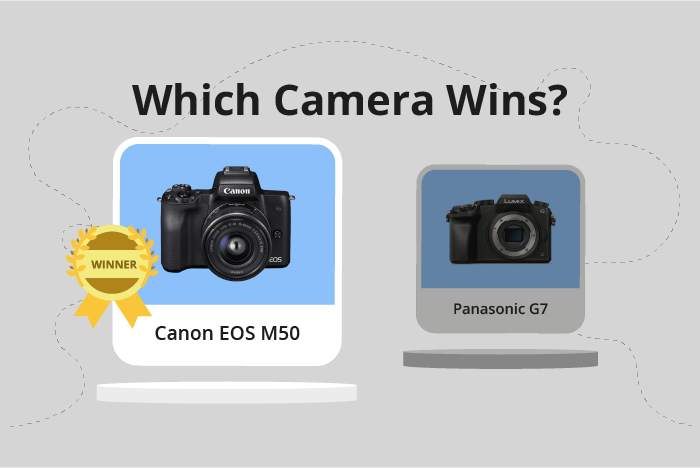Canon EOS M50 vs Panasonic Lumix DMC-G7 Comparison
Canon EOS M50

Panasonic Lumix DMC-G7

The Canon EOS M50 emerges as the winner with a score of 59/100, while the Panasonic Lumix DMC-G7 scores 52/100. Both cameras share similarities like being mirrorless and having similar launch prices, with the M50 priced at $779 and the G7 at $799.
The Canon EOS M50 is the superior camera due to its lighter weight of 390g, compared to the G7’s 410g. Additionally, it has a more compact size, measuring 116 x 88 x 59mm, while the G7 measures 125 x 86 x 77mm. These factors make the M50 more portable and convenient for photographers.
The Panasonic Lumix DMC-G7, however, has the advantage of being released earlier, in 2015, while the M50 was released in 2018. This may make the G7 more accessible and affordable to some users.
Taking all of these factors into account, the Canon EOS M50 stands out as the better option due to its lighter weight and more compact size. The Panasonic Lumix DMC-G7 could still be a suitable choice for those seeking an earlier release and potential affordability.
Canon EOS M50 vs Panasonic Lumix DMC-G7 Overview and Optics
The Canon EOS M50 outperforms the Panasonic Lumix DMC-G7 in optics, with a score of 59/100 compared to the G7’s 51/100. Both cameras share some common specifications, such as having a CMOS sensor, no image stabilisation, and similar lens mounts (Canon EF-M for the M50 and Micro 4/3 for the G7).
The EOS M50 has several advantages over the G7. Firstly, it has a higher megapixel count at 24, compared to the G7’s 16, which results in more detailed images. Additionally, the M50 has a faster shooting speed of 10 frames per second, allowing for better capture of fast-moving subjects. The M50 also features a more advanced Digic 8 processor and a larger APS-C sensor, both contributing to improved image quality.
On the other hand, the Lumix G7 has a higher DXOMARK score for its sensor at 75, compared to the M50’s 58. This suggests that the G7 may perform better in certain aspects of image quality, such as dynamic range and low-light performance. However, the G7’s slower shooting speed of 7 frames per second and lower megapixel count may limit its overall performance in comparison to the M50.
The M50’s superior optics, including a higher megapixel count, faster shooting speed, and advanced processor, contribute to its higher score. While the G7 has a higher DXOMARK score, its other specifications may not be enough to outshine the M50. Therefore, the Canon EOS M50 is the better choice for those seeking better optics in their camera.
Canon EOS M50 vs Panasonic Lumix DMC-G7 Video Performance
The Canon EOS M50 outperforms the Panasonic Lumix DMC-G7 in video capabilities with a score of 91/100, as opposed to the G7’s 83/100. Both cameras share some common specifications, such as 4K max video resolution and 3840 x 2160 max video dimensions. Additionally, both cameras have built-in time-lapse functionality.
The EOS M50 excels in its maximum video frame rate, offering 120fps compared to the Lumix G7’s 60fps. This higher frame rate enables smoother slow-motion footage and more flexibility in post-production for the M50. This advantage contributes to the M50’s higher video score, making it a better choice for videographers seeking superior slow-motion capabilities.
On the other hand, the Lumix G7 does not have any significant advantages over the M50 in video capabilities. Both cameras offer the same resolution and dimensions, but the G7 falls short in its frame rate offering. However, the G7 still performs well in its own right, with a respectable video score of 83/100.
Taking these points into account, the Canon EOS M50 emerges as the better choice for videographers due to its higher video score and superior maximum video frame rate. While the Panasonic Lumix DMC-G7 is a competent camera for video, it falls short when compared to the M50’s performance.
Canon EOS M50 vs Panasonic Lumix DMC-G7 Features and Benefits
The Canon EOS M50 emerges as the winner in the features category, scoring 70/100, while the Panasonic Lumix DMC-G7 trails behind with a score of 58/100. Both cameras share several specifications, making them comparable in some aspects. They both have a 3-inch screen, touchscreen capabilities, a flip screen, no GPS, and WIFI connectivity.
The Canon EOS M50 outshines the Panasonic Lumix DMC-G7 in terms of Bluetooth connectivity, which the Lumix DMC-G7 lacks. This feature allows users to connect their camera to other devices more conveniently, enabling seamless file transfers and remote control options.
On the other hand, the Panasonic Lumix DMC-G7 has a higher screen resolution at 2,360,000 dots, compared to the Canon EOS M50’s 1,040,000 dots. This means that the Lumix DMC-G7 provides a sharper and clearer image on its screen, giving users a better preview of their shots.
Taking these points into account, the Canon EOS M50 is the better camera when considering its features due to its higher score and the added convenience of Bluetooth connectivity. However, the Panasonic Lumix DMC-G7 still holds its ground with a superior screen resolution, which may appeal to users who prioritize image preview quality.
Ultimately, the choice between these two cameras will depend on individual preferences and priorities. The Canon EOS M50 offers a more comprehensive set of features, while the Panasonic Lumix DMC-G7 has a stronger display that may be more suitable for users who value image clarity on their camera screens.
Canon EOS M50 vs Panasonic Lumix DMC-G7 Storage and Battery
The Panasonic Lumix DMC-G7 outperforms the Canon EOS M50 in storage and battery with a score of 35/100 compared to the M50’s 13/100. Both cameras share similarities in storage, such as having a single memory card slot and accepting SD, SDHC, and SDXC cards. However, there are notable differences in their battery performance.
The Lumix G7 has a longer battery life, providing 350 shots compared to the M50’s 235 shots. Additionally, the G7 uses a DMW-BLC12E battery type and offers USB charging, making it more convenient for extended use. In contrast, the M50 uses an LP-E12 battery type and lacks USB charging.
Despite the lower score in this category, the Canon EOS M50 remains a viable option for some users, especially those who prioritize other features over battery life and storage. However, for those seeking better battery performance and charging convenience, the Panasonic Lumix DMC-G7 proves to be the superior choice in this comparison.
Alternatives to the Canon EOS M50 and Panasonic Lumix DMC-G7
Are you still undecided about which camera is right for you? Have a look at these popular comparisons that feature the Canon EOS M50 or the Panasonic Lumix DMC-G7:

